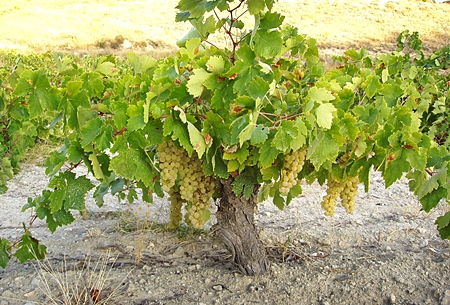The two wines this week are both light and fresh easy-drinkers. They’re both low in alcohol and low in acidity too. But they have something much more interesting in common.
The Airén (i-REN) grape hails from Spain and in terms of acreage, it’s probably the most widely planted wine-grape in the world. This is rather curious, because most people have never heard of it. Airén vineyards cover something like 578,000 acres: almost the size of Luxembourg. The vines are normally spaced wide apart with the result that the vineyards cover enormous areas. Nevertheless, the Airén remains unknown to most people outside Spain, because it’s not grown anywhere else. Even in Spain, it’s usually limited to the vineyards lying on the arid plains of La Mancha and is generally used as a blending grape. It can be used in both red and white wines and although in the past it has had rather a bad press, some excellent Airén wines are now being produced.
“Adventure” Airén 2010 (white) Spain. (Friendship Bt. 395)
This, I suspect, is one of them. Unusually for an Airén (which can have up to 14% alcohol content) this wine is only 11% alcohol and very pleasant it is too. It’s a pale straw colour and has an attractive fresh, floral aroma with gooseberries and hints of citrus. It’s a light-bodied wine with a soft-mouth feel and hardly any acidity.
 The Airén vine needs a lot of room (Photo: Bodegas Ambite)
The Airén vine needs a lot of room (Photo: Bodegas Ambite)
It’s well-balanced too, with a delightful, delicate fruity taste and the faintest dash of creamy sweetness on the finish. This is an attractive, undemanding easy-drinker but shows its best when you serve it really cold at around 9°C (about 48°F). It would make a good partner for salads, roast chicken and many Thai or Indian dishes.
I read somewhere that the vast Airén vineyards will eventually be reduced significantly, because some Spanish growers are replacing the grape with the increasingly popular Tempranillo. Grab some while you can.
“Villa dei Tigli” Trebbiano 2010 (white) Italy. (Friendship Bt. 365)
The Trebbiano grape is the second most widely planted wine grape in the world. It’s been known in Italy since Roman times. In France it’s called the Ugni Blanc, but amazingly the grape has fifty other names. The Trebbiano (treh-bee-AH-noh) grape produces more wine than any other variety, even though the Airén can claim more acreage. This example is a very pale straw-coloured wine from the Abruzzo region, which lies half way down the “leg” of Italy on the Adriatic side. The wine has a delicate floral aroma with hints of white fruit. But there’s something else, too.
Do you ever get that frustrating “tip of the tongue” experience? You know what I mean; there’s a word somewhere in the chasms of your mind but you just can’t seem to grasp it. Strangely, the exact cause is not fully understood by medical science. I often have the same problem when I attempt the Pattaya Mail crossword. Not being much good at crosswords, it can be a bit of a struggle, but at least the one in this paper is not too difficult. What am I doing talking about crosswords? This is supposed to be a wine column. (Glad you finally remembered – Ed.)
Anyway, I had the same experience trying to identify the aroma of this Trebbiano. Peaches and pears, I think. But I’m not a hundred percent sure. You’ll have to try it for yourself. You see, Trebbiano grapes tend to produce wines with little discernable aroma. But a modest aroma is not a bad thing. When you’re eating fairly simple food, a pleasant undemanding wine like this one is just right. A powerful fruity aroma with every swig is not always a welcome treat. The wine has a very soft and aromatic mouth-feel and a refreshing fruity taste with barely a trace of acidity. This will come as good news for those who like their whites soft and not too assertive.
It has just 11.5% alcohol content and is an attractive easy drinker, provided you serve it really cold. Actually, it made a surprisingly good partner to a piece of ageing Brie I found lurking at the back of the fridge.




